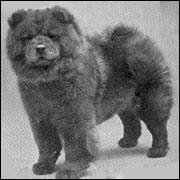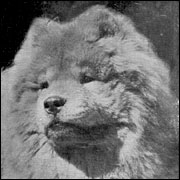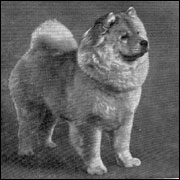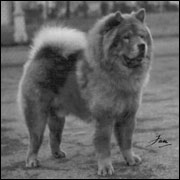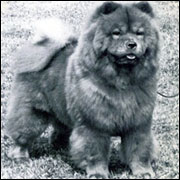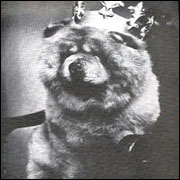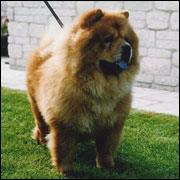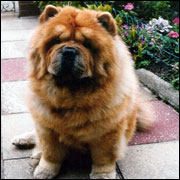Scientific research indicates that the Chow Chow was originated in China as long as 3,000 years ago. Historians have found references to Chow as far back as 11th Century B.C. The dogs being described as heavily built with harsh bristly hair, absolutely straight back legs and blue tongues. (Could this also describe the Chinese Shar-Pei??).
There is however another school of thought which believes that the Chow did not originate from China, barbarian ancestors of the Monguls used enormous dogs with features like a lion and black tongues, when they went to war against the Chinese 3,000 years ago.
Later they were adopted by the monasteries of Tibet, where even today they are monasteries that breed only blue chows.
As far back as the seventh century B.C. the Chow Chow was classified as a hunting dog, used to attack wolves and leopards. So strong and wilful was the breed then (as indeed they still are today) that huntsmen according to ancient records were obliged to control them with a contraption of straps around the dogs body and neck. Guarding was another of the breeds occupations, so too was the herding of cattle and other livestock. Even at the present time the breed is used for work in the field in China. Showing remarkable powers of scent, considerable staunchness at point, and exercising good sense and clever tactics when on the Francolin of Yunnan. During the last Century however field sports have been retrogressive in China, and the vast game preserves have been abolished.
The Nothern hunting park comprised an area as large as England and one of the Emperors of the Tang dysnasty had a staff of 10,000 huntsmen with kennels housing 5,000 chows.
A Bas relief of the Han Period (150 B.C.) shows 8 hunters carrying nets over their shoulders and accompanied by 8 dogs. It would appear that dogs and nets were set for quail and partridge hunting. There is much evidence today of ceramic models of the Chow Chow from the Han dynasty. |
There are many circumstances to explain why the Chow Chow was plenteously bred by the Chinese in early times. It was their only available native sporting dog, and it suited the conditions under which wild-fowl hunting and other field sports were conducted in China, prior to the invention of fire-arms. It was the accepted out of doors dog. In winter when the snow was on the ground Chows were used extensively as sledge haulers and beasts of burden, and in pastoral work of tending and driving sheep and cattle.
The economical Chinese were not likely to permit the Chows beautiful deep warm coat to be discarded as it was a marketable commodity. They seem always to have bred and reared these dogs for the sake of their valuable pelts. Indeed there are still thousands of small dogs farms scattered over the Nothern districts of Manchuria and Mongolia where flocks of Chows are bred and reared for their furs. When a Manchurian peasant girl is married she receives six chows as a dowry.
When the animal is killed it is strangulated so as not to damage the fur. The skins are dried and frozen and find a market in Mukden where they are cured.
Repellant thought the idea is to lovers of the Chow Chow, there is no doubt the meat is considered a desirable substitute for mutton. For centuries the Chinese have reared Chow Chow for eating. In the Quangtung and Quangsi provinces they specialise in rearing the Chows for table, black dogs were supposed to be the most nutrious. The puppies are fattened on rice and killed at the age of nine months. The hair is removed by scading, the carcase is then divided into sections and boiled for one hour. It is then fried in oil. The meat is cut into small pieces and cooked with dry mushrooms, preserved bean-cake, onions, ginger and water chestnuts.
There is a very old Chinese fairy story which reads as follows: "When the world was being created, what dog was allowed to lick up all the little pieces of blue sky which fell on earth when the stars were being set in their place?" "The Chow" said Li Fu, "and that´s how he got his blue tongue".
|
There are many Chow breeders of today that believe, and there is some scientific evidence to support the theory, that in the days of evolution the Chow came from the bear family and is not too canine at all.
The Chow Chow did not make his appearance in Western Europe until the late 18th Century, brought from China in the clipper ships. In 1820 an English newspaper reported an oriental dog imported from China that has a thick red coat and a blue black tongue, which attracted widespread attention. Some early reports of the Chow in England mention that several Chows were housed in the London Zoological Gardens and were identified as "the wild dog of China". It is known that Queen Victoria was given a Chow Chow in 1865.
In 1880 a chow bitch Chinese Puzzle was exhibited at the Crystal Palace Show in London. Her weight was thirty-two pounds and her height was sixteen inches at the shoulder, her owner was W. K. Taunton. But it was the Marchioness of Huntley who was the pioneer of the breed in England. In 1887 she imported a male dog who she called Periodot, she bred Periodot II whom Lady Granville Gordon bought and with whom she established a famous Chow kennel. Lady Faudel Philips became the leading breeder and exhibitor in England until about 1898, she was the daughter of Lady Granville Gordon. In 1895 the English Chow Chow Club begins.
Written by Iris Bowker |



